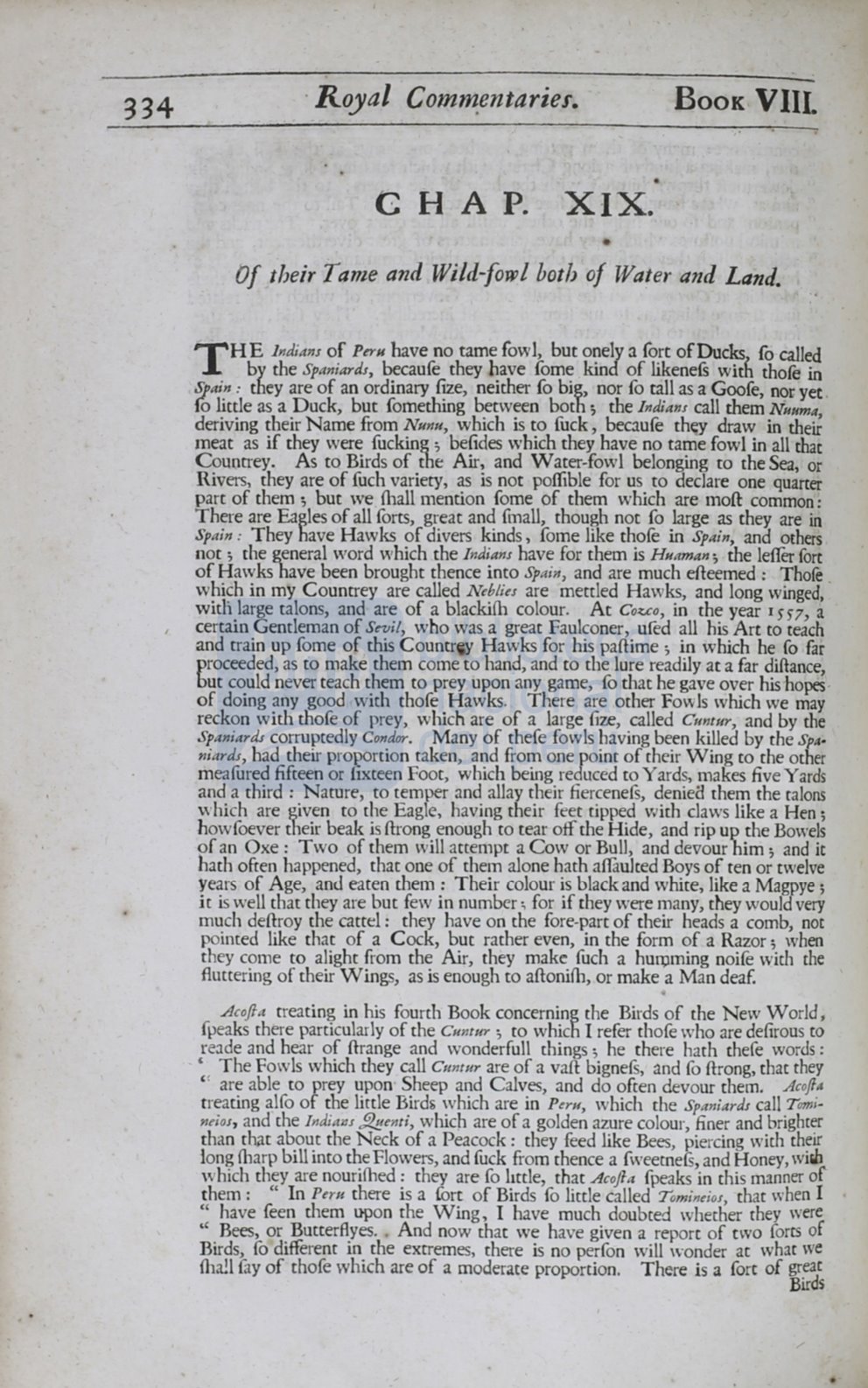

334
·
R.oyal
Commentaries.
BooK
VIII.
•
CH AP.
XIX.
Of their Tame and Wild-fowl botb of
Water
and Land.
T
HE
india?Js
of
Peru
have no
tame
fowl,
but onely a fort
of
Ducks
fo
called
by the
Spaniard!,
becaufe they have fome kind of likene{S with thofe
in
~ain
:
they are of an ordinary
f
12e, neither fo big, nor fo tall as a Goofe, nor
yet
fo
little as a Duck, but fomething between both ; the
Jndian.r
call them
Nuuma,
deriving their Name from
Nunu,
which is to fuck, becaufe they draw
in
their
meat as
if
they were fucking; befides which they have no tame fowl
in
all
that
Counrrey. As to Birds of the Air, and Water-fowl belonging to the Sea, or
Rivers, they are of fuch variety, as is not poffible for us to declare one
quarter
part of them ; but we
{hall
mention fome of them which are molt common:
here are Eagles of all forts, great and fmall, though not fo large as they are in
Spain :
They have Hawks of divers kinds, fome like thofe
in
Spain,
and others
not; the general word which the
Jndian.r
have for them
is
H11aman;
the leffer fort
of Hawks have been brought thence into
Spain,
and are much efieemed
:
Thofe
which in my Countrey are call
ed Nehlies
are mettled Ha ks, and long winged,
witn large talons, and are of a
black.Uhcolour. At
Couo,
in the
year
1
sr7,
a
certain Gentleman of
Sevil,
wh
o was a great Faulconer, ufed all his Arc to teach
and train up fome of
this
Countr y Hawks for his pafiime; in which he
[o
far
proceeded, as
to
make them come to hand, and
to
the lure readily at a far diftance,
but could never teach them to prey upon any game, fo that he gave over
his
hopes–
of doing any good with thofe Hawks. There are other Fowls which we may
reckon
with
tliofe of prey, which are of a large fize, called
Cunt11r,
and by the
Spaniards
corruptedly
Condur.
Many of thefe fowls having been killed by the
Spa·
niards,
had their proportion taken, and from one point of their Wing to the other
meafured fifteen or fixceen Foot, which being reduced to Yards, makes five Yards
aod a third : Nature, to temper and allay their fiercenefs, deniea them the talons
whi h are given to the Eagle, having their feet tipped
v;
ith claws like a Hen;
howfoever their beak is {l:roog enough
to
tear off the Hide, and rip up the Bowels
of an Oxe : Two of them \
ill
attempt a Cow or Bull, and devour him ; and
it
hath often happened, that one of them alone hath affaulced Boys of ten or twelve
years of Age, and eaten them
:
Their colour is black and white, like a Magpye ;
it
is
well that they are but few in number; for if rhey were many, they would very
much defiroy the cattel : they have on the fore-part of their heads a comb, not
p inted like that of a Cock, but rather even, in the form of a Razor; when
they come to alight from the
Air,
they make fuch a hu111ming noife with the
fluttering of their Wings, as is enough to afionifh, or make a Man dea£
Acofta
treating
in
his
fourth Book concerning the Birds of the New World,
fpeaks there particularly of the
Cuntur
;
to
which I refer thofe \ ho are defirous to
reJde and hear of firange and wonderfull things ; he there hath thefe words :
' The Fo
ls which they call
Cunrur
are of a vafr
bigne~,
and
[o
!l:rong, chat they
' ~
are able to prey upon Sheep and Calves, and do often devour them.
Acoffa
treating alfo of the little
Bird~
which are in
Peru,
'
hich the
Spaniards
call
Tomi–
neio1,
and the
Jndiavs
~enti,
which are of a golden azure colour, finer and brighter
than that about the Neck of a Peacock: they feed like Bees, piercing with their
long fharp bill into the Flowers, and fuck from thence a
f
weetnefS, and Honey,
wi'11
\\hich they are nourHhed : they are fo little, that
Acoffa
f
peaks in chis manner of
them:
"
In
Peru
there
is
a
fort
of Birds fo little called
Tomineiof,
chat when I
' have feen them upon the Wing, I have much doubced ' hether they were
'' Bees, or Butterflyes. And now chat we have given a report of two forts of
Birds,
Co
different
in
the extremes, there
is
no perfon will wonder at what we
fua!l fay
of
thofe which are of a moderate proportion. There is a fort of
~~d~
/














